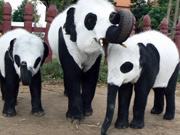

Rare albino wallabies are thriving on a small Tasmanian island due to a lack of predators and because locals think they are 'cute', experts have revealed.
The rare genetic mutation of the red-necked or Bennett's wallaby is the result of an imbalance of melanin which gives the creatures snow-white fur and pink eyes, claws and nose.
They are sensitive to sunlight, often have vision problems and are prone to cancer, all of which negatively impact their survival rates.
But an absence of predators on Bruny Island, south of Hobart, has helped its albino wallaby population swell to up to 200, nature park operator Tonia Cochrane said.
Normally these (animals) would be born and they would be predated on or they would just die fairly early but here there's no predators and locals think they are kind of cute,' Mr Cochrane told AAP.
'That means they live to reach breeding age and pass on the gene and there is quite a decent-sized community of them here on the island.'
There is no discrimination within the wallaby community, with breeding between albino and the standard brown wallaby quite common, Dr Cochrane added.
The albino creature is one of the most popular animals among visitors to the island.
'They are just so unusual,' she said.
'They're like something out of Alice In Wonderland ... they don't quite look real.
Rare albino wallabies are thriving on a small Tasmanian island due to a lack of predators
 |
Day|Week

 Kenyan woman's crappy photoshopped pictures make her a web celebrity
Kenyan woman's crappy photoshopped pictures make her a web celebrity Magnificent view of E. China's Anhui province
Magnificent view of E. China's Anhui province Global landmarks captured in striking shots
Global landmarks captured in striking shots Thailand Elephants Disguised as Pandas Sparks Debates
Thailand Elephants Disguised as Pandas Sparks Debates College girl dresses as mermaid to mark World Water Day
College girl dresses as mermaid to mark World Water Day J-15 fighters in drill on Chinese aircraft carrier
J-15 fighters in drill on Chinese aircraft carrier 96-Year-Old Veteran Becomes Fashion Icon
96-Year-Old Veteran Becomes Fashion Icon Creative mother produces 232 unique breakfasts
Creative mother produces 232 unique breakfasts Charming folk customs in Kalajun Grassland
Charming folk customs in Kalajun Grassland A glimpse of ships and boats commissioned to PLA Navy in past 3 years
A glimpse of ships and boats commissioned to PLA Navy in past 3 years